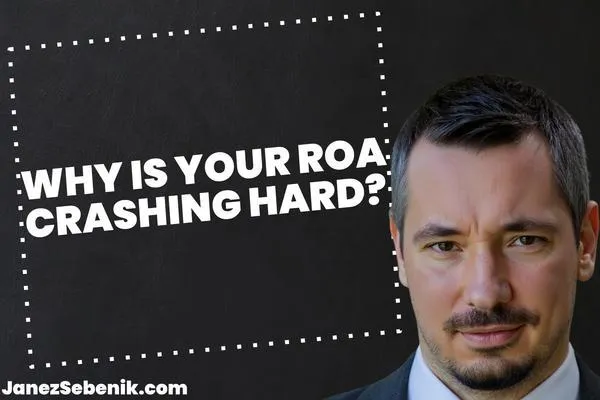
What Does a Decrease in ROA Mean?
Return on Assets (ROA) is like a report card for companies. It shows how well they're using their stuff to make money. When ROA goes down, it's not great news.
A decrease in ROA means a company isn't making as much profit from its assets as it used to. This could be a red flag for investors. It's like a store that's not selling as much even though it has the same amount of products.
Think of ROA as a money-making efficiency score. When it drops, the company might be struggling to turn its resources into cash. This could mean trouble ahead if things don't improve.
Key Takeaways
A falling ROA suggests a company's profitability is slipping
ROA helps you spot potential issues in a company's financial health
Comparing ROA across similar companies can give you valuable insights
Understanding ROA
ROA tells you how well a company uses its stuff to make money. It's a key number that shows if a business is doing a good job or not.
Definition of ROA
Return on Assets (ROA) is like a report card for businesses. It shows how good they are at turning their assets into profits.
Think of it as a measure of efficiency. The higher the ROA, the better the company is at using what it owns to make money.
ROA is super helpful when you're looking at companies in the same industry. It lets you compare apples to apples.
The ROA Formula
Ready for some simple math? Here's how you calculate ROA:
ROA = Net Income / Average Total Assets
Net Income is the money left after all expenses. Average Total Assets is what the company owns, averaged over a year.
The ROA formula is pretty straightforward. You take the profit and divide it by the stuff the company has.
A higher ROA means the company is more efficient. It's squeezing more profit out of its assets.
Remember, ROA can vary by industry. So always compare companies in the same field.
Analyzing ROA Decline
A dropping ROA isn't great news. Let's dig into what it means and why it happens.
Interpreting a Decrease in ROA
When your ROA goes down, it's like your business is losing its mojo. You're not squeezing as much profit out of your assets as before. Bummer.
This could mean you're spending more to make less. Or maybe your assets aren't pulling their weight. Either way, it's a red flag for your financial performance.
Investors might get spooked. They want to see their money working hard. A falling ROA? That's like watching your star player bench-warming.
For you as a manager, it's time to put on your detective hat. Where's the leak in your profit boat?
Factors Affecting ROA
Your ROA can take a hit from many angles. Let's break it down.
First up, profits. If they're shrinking, your ROA follows suit. Maybe your costs are creeping up, or sales are sliding. Both bad news for your bottom line.
Next, look at your assets. Are they bloating without boosting profits? That's like buying a fancy new machine that just sits there looking pretty.
Debt can be a sneaky ROA killer too. More loans mean more assets, but if they're not cranking out profits, your ROA suffers.
Don't forget about inventory. Too much stock sitting around? That's dead weight on your balance sheet.
Lastly, market changes can throw a wrench in things. Even if you're doing everything right, a shifting industry can drag your ROA down.
Comparing ROA with Other Metrics
ROA isn't the only game in town. Let's look at how it stacks up against other key players in the financial world. You'll see why ROA matters and how it fits into the bigger picture.
ROA vs. ROE
You've heard of ROE, right? It's ROA's cool cousin. While ROA looks at how well a company uses all its assets, ROE focuses on shareholder equity.
Here's the deal: ROE tells you how much profit a company makes from the money shareholders invested. It's like asking, "How much bang do I get for my buck as an investor?"
ROA, on the other hand, shows how efficiently a company uses everything it owns to make money. It's like asking, "How good is this company at turning stuff into cash?"
Sometimes, a company might have a high ROE but a low ROA. That could mean they're using debt to boost profits. Not always a bad thing, but worth keeping an eye on.
Asset Turnover and Profit Margin
Now, let's break ROA down into its parts. You've got asset turnover and profit margin. These two are the secret sauce of ROA.
Asset turnover is about how much revenue a company squeezes out of its assets. It's like asking, "How hard are these assets working?"
Profit margin tells you how much of that revenue actually turns into profit. It's the "How much do we keep?" question.
Put them together, and you get ROA. A company can improve its ROA by either selling more stuff (higher asset turnover) or keeping more of what it sells (higher profit margin).
Some companies, like supermarkets, have high turnover but low margins. Others, like luxury brands, might have lower turnover but fat margins. Both can lead to a good ROA.
Practical Implications of ROA
ROA is a big deal for your money and business. It tells you how well a company uses what it's got. Let's dive into how it affects investing and running a business.
Impact on Investment Strategy
You're an investor looking for the next big thing. ROA is your secret weapon. It shows you which companies are killing it with their assets.
High ROA? That's a green light. It means the company's squeezing every penny out of what they own. Low ROA? Proceed with caution. They might be struggling to make their stuff work for them.
But wait, there's more! Compare ROA across similar companies. It's like a financial cage match. Who's the real champ at making money from their assets?
Remember, ROA can change. A dropping ROA might mean trouble ahead. But it could also be a chance to buy low before things turn around.
ROA for Business Management
You're running the show now. ROA is your report card. It tells you if you're using your company's stuff well.
Got a low ROA? Time to put on your thinking cap. Are you sitting on too much inventory? Maybe your equipment's outdated. Or you're not selling enough with what you've got.
High ROA? Pat yourself on the back, but don't get cocky. Look for ways to keep that momentum going. Can you do even more with less?
ROA helps you make big decisions. Should you buy new equipment? Expand to a new location? If it won't boost your ROA, think twice.
Remember, ROA is just one piece of the puzzle. Use it with other financial ratios to get the full picture. It's like having a financial Swiss Army knife in your pocket.
Limitations and Considerations
ROA isn't perfect. It's got some blind spots you need to know about. Let's break it down so you can use ROA like a pro.
Understanding the Limitations of ROA
ROA doesn't tell the whole story. It's like judging a book by its cover - you might miss the good stuff inside.
First off, ROA doesn't care where the money comes from. Debt or equity? It's all the same to ROA. This can make a company look better than it really is.
Asset values can be tricky too. Old assets might be undervalued on the books. New ones might be overvalued. Either way, it messes with your ROA.
And don't forget about intangibles. Things like brand value or patents don't show up in ROA. But they're super important for some businesses.
ROA in Different Industries
You can't compare apples to oranges. The same goes for ROA across industries.
Take real estate. They've got tons of assets, so their ROA might look low. But that doesn't mean they're not making bank.
On the flip side, a tech company might have a sky-high ROA. They don't need many assets to rake in the cash.
Manufacturing companies are somewhere in the middle. They need equipment, but not as much as real estate firms.
So when you're looking at ROA, make sure you're comparing within the same industry. It's the only way to get a fair picture.
Fiscal Period Comparisons
Time matters when it comes to ROA. You can't just look at a single snapshot and call it a day.
Companies change over time. They buy new assets, sell old ones. Their profits go up and down. All this affects ROA.
Fiscal years can be tricky too. Not every company uses the same calendar. So make sure you're comparing apples to apples.
And don't forget about seasonal businesses. Their ROA might look great one quarter and terrible the next. You need to look at the full year to get the real story.
Remember, ROA is just one tool in your toolkit. Use it wisely, and always look at the big picture.
Calculating ROA: A Step-by-Step Approach
Let's break down ROA so you can master it. We'll crunch some numbers in Excel and dive into the key parts of the formula. Ready to become an ROA pro?
Walkthrough Calculation in Excel
First, open Excel. It's your new best friend for ROA calculations.
Start with two columns: one for net income, one for total assets.
In cell A1, type "Net Income". In B1, put "Total Assets".
Now, let's say your company made $100,000 last year. Pop that in A2.
Your total assets were $500,000. That goes in B2.
In C1, type "ROA". Here's the magic formula for C2: =A2/B2
Hit enter. Boom! You've got your ROA. Excel will show it as a decimal. Multiply by 100 for a percentage.
Factors in the ROA Equation
ROA has two main players: net income and total assets.
Net income is what's left after you've paid all the bills. It's your profit after taxes.
Total assets include everything your company owns. Cash, inventory, equipment - it all counts.
Want a higher ROA? You've got two options:
Boost your net income
Use fewer assets to make that income
It's like a game of efficiency. How much profit can you squeeze out of each dollar of assets?
Remember, ROA can vary by industry. A tech company might have a different "good" ROA than a factory.
Keep an eye on your ROA over time. Is it going up? You're getting more bang for your asset buck!
Conclusion: What Next After a ROA Decrease?
So your ROA dropped. Don't panic! It's not the end of the world.
First, take a deep breath. Now, let's figure out why it happened.
Did your profits shrink? Or did your assets grow faster than your income? Either way, it's time to put on your detective hat.
Look at your expenses. Are there any money-sucking vampires you can stake? Cut 'em loose!
Next, check your assets. Are they all pulling their weight? If not, it might be time to Marie Kondo your balance sheet.
Don't forget about your team. They're your secret weapon. Get them fired up about boosting efficiency.
Here's a quick checklist to get you back on track:
Trim the fat from your expenses
Maximize asset utilization
Pump up your sales
Explore new revenue streams
Invest in employee training
Remember, ROA is just one piece of the puzzle. Keep an eye on other metrics too.
Lastly, consider the bigger picture. Are you investing in long-term growth? Sometimes, a temporary dip in ROA can lead to bigger wins down the road.
Stay focused, stay hungry, and keep pushing forward. You've got this!
